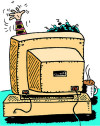Brandy redux
Posts: 2376
Joined: 2/7/2007
Status: offline

|
As can be seen in the 'Paper Stock Not Supported' information at the bottom of this message, "while attempting to print to a network printer from a Windows NT® or Windows® 2000 workstation, an error message might state that the printer "does not support" or "cannot find the paper stock." This issue is caused by a conflict between the program and the network printer driver.
As can also be seen in that information, loading a different printer driver to emulate the printer and selecting that printer when printing from Calendar Creator™ 12 can help resolve the issue.
Even though that information is for Calendar Creator 12, this problem is known to exist in most versions of Broderbund's Calendar Creator.
It should be kept in mind, though, that some versions of Calendar Creator will print ONLY to the default printer. So, it may be necessary to go to Printers & Faxes in Control Panel and temporarily set the emulated printer driver as the default printer before opening Calendar Creator.
Paper Stock Not Supported
While attempting to print to a network printer from a Windows NT® or Windows® 2000 workstation, an error message states that the printer "does not support" or "cannot find the paper stock." A conflict between the program and the network printer driver typically causes this issue. Loading a different printer driver to emulate the printer and selecting that printer when printing from Calendar Creator™ 12 can help resolve the issue. This note describes changing the printer driver. Contact the printer manufacturer to identify the driver (or drivers) that will emulate the printer in use.
NOTE: Calendar Creator™ 12 is not a network-supported application. Therefore, performance is not guaranteed within a network environment.
The Windows® CD may be required to complete the steps that follow.
Printer Emulation
If the printed output from a particular program is incorrect, or if nothing prints at all, there may be a conflict between the program and the printer. Printer conflicts are typically resolved by loading a different printer driver to emulate the printer being used and selecting that printer emulation when printing from the affected program. Contact the printer manufacturer to identify what driver or drivers will emulate the particular printer in use. The steps below describe changing the printer driver.
1. Close any open programs or windows and return to the desktop.
2. Double-click the My Computer icon.
3. Double-click the Printers icon.
NOTE: For Windows® XP users, perform the following procedure and then skip to Step 5.
1. In the Other Places panel on the left side of the window, click Control Panel.
2. Click the Printers and Other Hardware button.
3. Click the Printers and Faxes button.
4. In the Printer Tools panel on the left side of the window, click Add A Printer. The Add Printer Wizard dialog should now open.
1. Double-click the Add Printer icon. The Add Printer Wizard dialog should now open.
2. Click Next.
3. If the printer is connected to the computer directly, select Local. If the printer is accessed through a network, select Network.
4. Click Next. The window that appears displays a list of printer manufacturers on the left side and the corresponding models on the right side.
NOTE: For Windows® XP users, remove the check mark from the option to automatically detect Plug And Play printers.
5. Select the appropriate manufacturer and model for the emulation printer obtained from the printer manufacturer (see Printer Emulation).
NOTE: If the manufacturer or model is not in the list, refer to the printer documentation or contact the printer manufacturer to determine another emulation driver for the printer.
6. In the screen that opens, configure the port the printer is attached to. (Most of the time, a local printer will be attached to LPT1.) If a different LPT port or alternate connection is used such as USB, select the appropriate option and click Next. #
7. Name the printer or use the default printer name. The opportunity to select this printer as the default printer is also presented. If Yes for the default option is selected, all Windows® applications will use this printer automatically. Select No if a default printer in Windows® is already selected and you want to have this printer driver available for printing when using a particular program.
NOTE: Some programs (typically older programs) only print using the default printer and will not allow a different printer to be chosen when printing. If the program you are having issues printing from does not allow a different printer to be chosen when printing, set the emulation printer you are installing as the default for now. After troubleshooting, the default printer can be changed back to the correct printer by repeating Steps 1-3 to open the printers window. Right-click the correct printer icon and left-click Set As Default from the menu that appears.
8. Select Yes for the option to print a test page and click Finish. Insert the Windows® CD if prompted.
9. If the test page prints correctly, the new driver that was loaded is a valid emulation for the printer. With the installation complete, the printer should appear in the Printers window.
10. Close any open windows and return to the desktop.
11. Launch the program and try printing using the newly installed emulation printer.
< Message edited by Brandy redux -- 9/18/2010 1:12:08 PM >
_____________________________
For More Help: Click on the FAQ link at the top of this page Then, click on the All FAQ's button on the next page To contact me by email, please send your message to pine_97@yahoo.com
|

 Printable Version
Printable Version





 New Messages
New Messages No New Messages
No New Messages Hot Topic w/ New Messages
Hot Topic w/ New Messages Hot Topic w/o New Messages
Hot Topic w/o New Messages Locked w/ New Messages
Locked w/ New Messages Locked w/o New Messages
Locked w/o New Messages Post New Thread
Post New Thread